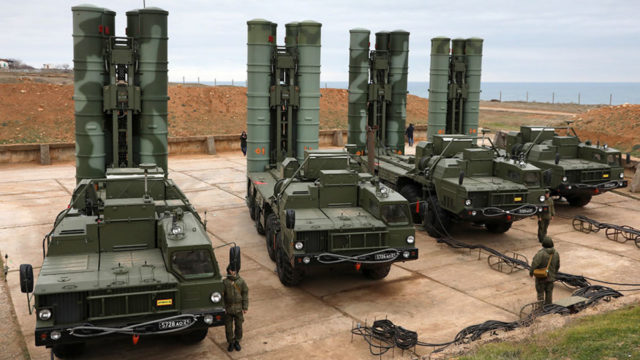
Russia’s Air Defense Capabilities Boosted by Automated Systems
Publication: Eurasia Daily Monitor Volume: 18 Issue: 44
By:

Since Moscow initiated its long-term military modernization program over a decade ago, an important focal point in this complex process has proved to be the emphasis upon automated command and control (C2). The digitization of Russia’s C2 structures aims to enhance the speed and efficiency of the military decision-making process in order to achieve an edge over any potential adversary during combat operations (see EDM, June 11, 2019). While such technologies also include the other elements of C4ISR (Command, Control, Communications, Computers, Intelligence, Surveillance and Reconnaissance), Russian military terminology uses the phrase “automated control system” (avtomatizirovannoy sistemy upravleniya—ASU). Among the variants of the ASU, depending on the arm or branch of service, there are the Akatsia-M, Andromeda (Airborne Forces variant) and the Unified System for Command and Control at the Tactical Level (Yedinaya Sistema Upravleniya v Takticheskom Zvene—YeSU-TZ). Now, Moscow has introduced an advanced ASU to boost the capabilities of air defense for the Aerospace Forces (Vozdushno Kosmicheskikh Sil—VKS); yet this latest breakthrough in automated systems offers benefits for other arms of service (Riafan.ru, March 15).
The new ASU introduced into the VKS in the Central Military District (MD), designated as “Fundament-M,” greatly enhances air-defense capabilities by integrating the various platforms such as the S-400 and Pantsir-S1 with related radars and unites these in a single circuit. The Fundament-M has been successfully tried and tested during military exercises in 2020, and it will be procured throughout the national MD system. Earlier this month, the Fundament-M went on combat duty in the Central MD, unifying the entire Urals and Volga regions as well as the Engels airbase, marking a significant boost for the VKS (Riafan.ru, March 15).
The former head of the anti-aircraft missile forces of the Russian Air Force, Alexander Gorkov, explained: “The foundations of this system were laid thirty years ago. Now its implementation is only being completed using the technologies that are available today. Previously, we had automated systems in the western, north-western and eastern directions. The center of Russia did not have this at the level of divisions and air-defense armies, only at the level of regiments. To complete the transition of forces into a single space, there was not enough manpower and resources” (Izvestia, March 14).
While the VKS and air defenses are the principal beneficiaries, the Fundament-M can also offer automated C2 over Ground Forces and naval forces in coastal areas. Unlike other variants of ASU, the Fundament-M can interface simultaneously with several radars and missile systems of different types and purposes. It can also be used to monitor the air traffic of civil aircraft (Izvestia, March 14). The commander of the Central MD, Colonel General Alexander Lapin, noted that in 2020, the range of destruction of air targets in the district increased two and a half times. The district’s air defense received the S-400 Triumph long-range system and modern Buk-M3 medium-range system. In exercises conducted within the MD in 2021, an S-400 linked to the Fundament-M was used to rehearse defense against enemy missile strikes at low, medium and high altitudes, involving a number of radars linked into the Fundament-M: Nebo-M, Nebo-U, Kasta-22, Terek, Desna and Oborona (Izvestia, April 23, 2020 and March 14, 2021).
The main role in the process of combining and speeding up the means of air defense in the VKS will be played by the Fundament-M. This system will be located in the radio engineering regiments. Mobile posts mounted on a truck chassis will collect and process the data from radars and automatically transmit this to headquarters and air-defense command posts. Reportedly, five of these Fundament-M systems have already arrived in the Central MD. The information gathered and transmitted through the Fundament-M using closed communications channels is sent to the VKS control center. This facilitates real-time monitoring of the situation in the air over the entire country in peacetime and wartime. Also currently under development is a subsystem similar in its characteristics to the YeSU-TZ. The Polyana-D4M1 and Barnaul-T automated control systems are used to interface anti-aircraft systems of the Ground Forces at various ranges (Izvestia, March 14).
Aytech Bizhev, the former deputy head of the Air Force for the Commonwealth of Independent States (CIS) air-defense system, explained that the air force and air-defense armies are subordinate to the commanders of the military districts. “Earlier, when such armies were controlled by the commander-in-chief of the Air Force, we had our own automated system. And the headquarters of the districts were not included in it. It was extremely inconvenient, the information went through parallel channels.” With the introduction of the Fundament-M, everyone is working in a single information field, starting from the central command post of the General Staff. Bizhev noted that Fundament-M allows all personnel involved to see the actions of their adversaries and oversee operations in real time. This increases the efficiency of decision-making, which is especially important in a modern, fast-moving operational environment (Izvestia, March 14).
While the wider introduction of the latest highly advanced ASU will clearly benefit the VKS and further strengthen Russia’s air-defense capabilities, it also marks a new step toward linking and integrating such automated systems to greatly enhance and improve the overall speed of C2. This adoption of high technology in Russia’s Armed Forces equally increases the demand for greater numbers of well-trained contract personnel in order to maximize the utility of such systems. By digitizing and making C2 automated throughout the military structures, the General Staff wants to promote the image of the country’s Armed Forces as truly representing a 21st century fighting force; in the area of ASU technology and overcoming the challenges of systems integration, Moscow is certainly making marked progress. Further technological development, field testing in exercises and training of specialist personnel may well result in a much improved air-defense capability. It remains unclear, however, as to the timescale for rolling out this new ASU across the MD system.



